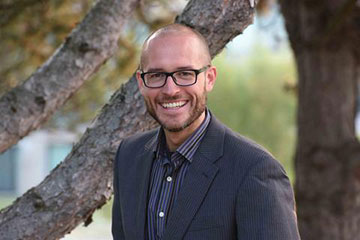
A research team’s model to explain photosynthesis lays out the next challenging phase of research on how green plants transform light energy into chemical energy. [Image: Tamar Melen and QMO Lab, UC Riverside]
A network model of photosynthesis, based on real-world inputs, shows how light-harvesting antennae on photosynthetic organisms are able to minimize input noise and maximize power-conversion efficiency, an international research team reports (Science, doi: 10.1126science.aba6630).
The model, which has implications for human-made energy systems and networks, reveals that phototrophic organisms achieve near-unity quantum light-harnessing efficiencies in part by tuning the wavelength of light absorbed, the researchers say. It provides a unified, theoretical basis for the observed wavelength dependence of green plants, purple bacteria and green sulfur bacteria, they write.
A delicate interplay
In photosynthesis, the researchers say, “the delicate interplay of quantum effects with molecular mechanisms of energy management … has been explored across diverse phototrophs, but the elementary connection behind highly robust light energy harvesting and energy fluctuations has not been established.”
Now, not only can the new model explain what nature is up to, says co-author Nathaniel Gabor, a professor of physics and astronomy at University of California, Riverside, USA—it also gives insight on how solar and other artificial energy-harvesting networks could be designed to deliver maximum efficiency under dynamic light conditions.
“It is extremely rare to find a general organizing principle in biology,” Gabor says. “We were able to show that this [light-harvesting ability] is general across some of the most important organisms under investigation.”
A noise-canceling model
For the work, the team constructed a noise-canceling model that shows how light-harvesting antennae—whether for biological or nonbiological entities—can be wavelength-tuned to minimize noise and maximize power-conversion efficiency. Team members included researchers from the University of Glasgow, Scotland; Canada Institute for Advanced Research, Canada; and Vrje Universiteit Amsterdam, the Netherlands.
The model was tested with inputs for full solar exposure, light under a canopy of vegetation and light filtered under seawater.
“The data and analysis are published on a free, public depository so that it is easily accessible,” Gabor says. “Anyone who is willing to look is able to input the solar spectrum and compare to their favorite photosynthetic organism. We’ve even done additional calculations on several other species, and found remarkable consistency with our predictions.”
Reaching across disciplines

Nathaniel Gabor [Image: CIFAR]
The most difficult part of the work, Gabor says, was “learning more about biology and getting my ideas to reach across disciplines—biology, physics and network engineering. Once I met my co-authors, Richard Cogdell [University of Glasgow] and Rienk van Grondelle [Virje Universiteit Amsterdam], we were excited to test how general the model really is.”
Gabor says his interest in photosynthesis “was inspired by a basic question in understanding solar cells.” As a Ph.D. student, he investigated carbon nanotube p-n junction devices. “Carbon nanotubes, like many quantum materials,” he says, “exhibit the very important property that the absorption wavelengths in the material depend on some critical size—for example, the radius in carbon nanotubes.”
Gabor says, “I asked myself: what color absorption—and therefore what size of nanotube—would I choose if I wanted to build a nano solar cell? I then looked at the solar spectrum on Earth and decided that my nanotube should absorb the maximum power in the spectrum, which occurs in the green wavelengths.”
But then he encountered a problem: While Gabor expected that his quantum solar cell should absorb green light, nature does the exact opposite.
“Plants are spitting out all of the green light and are instead absorbing anything except green light,” he says. “This forced me to re-think what should be optimized if you are trying to make a quantum solar cell. I guessed that plants are not interested in absorbing the maximum amount of light, but are instead trying to control the amount of light energy entering the plant.”
The key, Gabor says, “is stated explicitly in the last paragraph of our paper: ‘Fluctuations fundamentally limit the efficiency of networks and must be avoided.’”
Applying to the grid
He gives an example of how the team’s model might apply to a large-scale solar energy grid:
“Imagine my grid is based on many different solar farms,” Gabor says, “some receiving very bright light, some very little light. My goal is to keep the power flowing into my house at a steady rate—not too much, not too little.”
Today, power flow is controlled locally, Gabor says. “If the southern California sun is too bright, we need to stop dumping power into the grid. If we don’t, we risk overpowering the entire system. Yet, in Washington, D.C., it might be a dark stormy day, and will not receive sufficient light energy to power my house lamp,” he says.
“If we could correlate the two places,” Gabor says, “maybe I could take more power from California when I needed it, but send power to D.C. when I am getting too much.”
More to explore
Moving forward, Gabor says, “our findings will inspire comprehensive experiments, in which the light environment is carefully controlled while the absorption spectrum of adaptable model organisms is monitored.”
By developing noise-canceling antennae as a technological foundation, Gabor says, “natural and artificial energy-harvesting networks—from bacteria thriving underwater to extended solar power grids—could be adapted to efficiently convert noisy inputs into robust outputs.”
Moreover, Gabor says, “we need to find the connection between vastly different size and energy scales—from the microscopic quantum mechanics to the macroscopic success or failure of photosynthetic organisms in nature. Our work gives a general framework, though much more work is needed to explain the highly complex and detailed processes of photosynthesis.”
